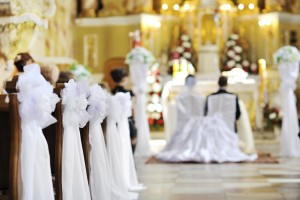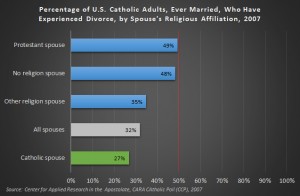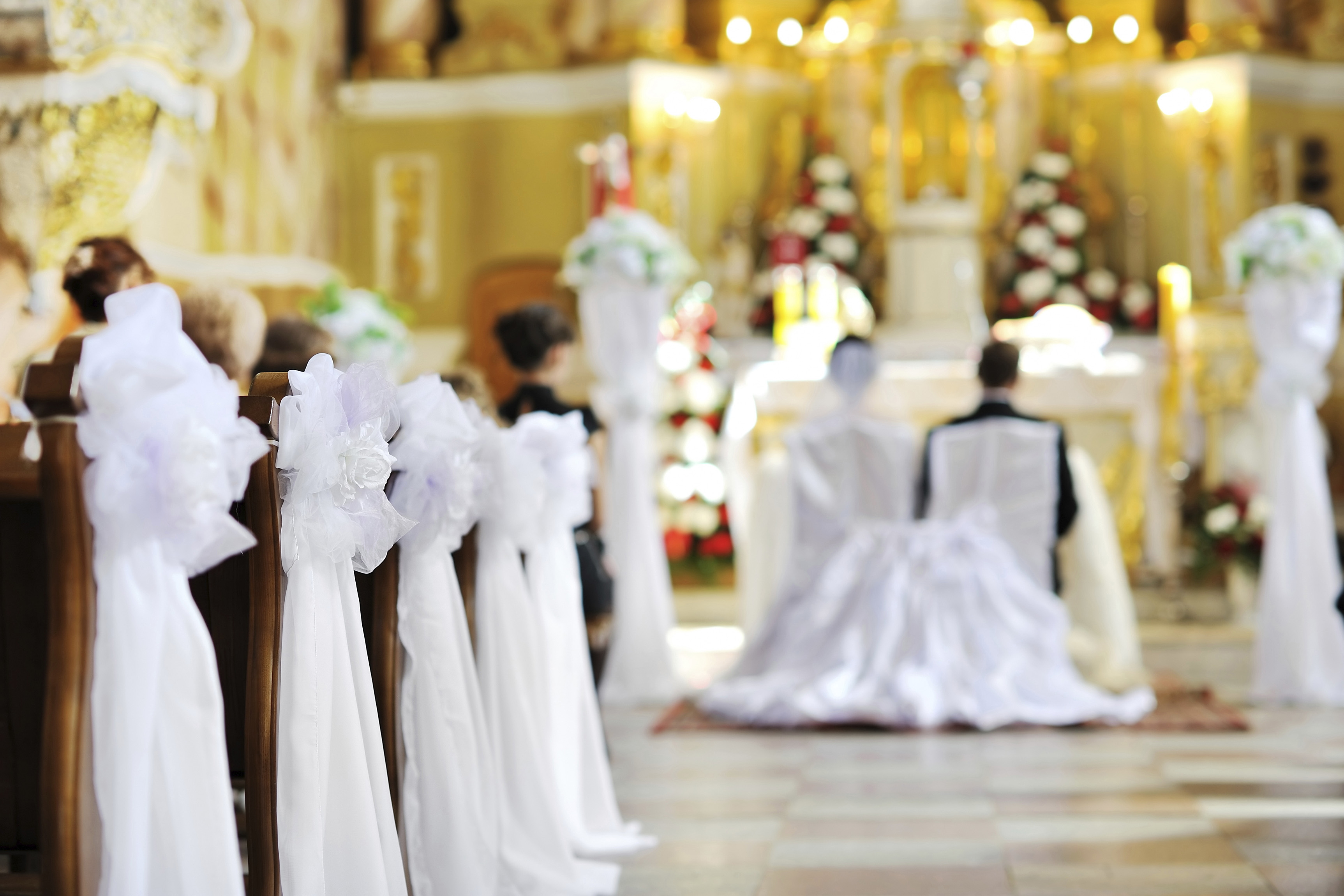 It would seem that figuring the divorce rate would be a rather simple thing. But like most sociological phenomena, there are many complicating factors (especially today when even simple definitions are breaking down). But however you measure divorce, it would seem that practicing Catholics fare far finer than any other group, believer or non-believer.
It would seem that figuring the divorce rate would be a rather simple thing. But like most sociological phenomena, there are many complicating factors (especially today when even simple definitions are breaking down). But however you measure divorce, it would seem that practicing Catholics fare far finer than any other group, believer or non-believer.
I recently read a CARA (Center for Applied Research in the Apostolate) study and would like to share a few thoughts from it. The fuller commentary by Mark Gray is over at the CARA blog here: Divorce Still Less Likely Among Catholics
First, the question arises as to how best to measure the divorce “rate.” There have been several methods used over the years, some of which have lost accuracy since fewer and fewer people are ever getting married in the first place. Hence, some problems have arisen in referencing traditional divorce measures:
Problem 1 – The “Crude rate” numbers have become skewed. The “crude rate” is the total number of divorces in a year per 1,000 of the population. But the problem with this number is that the number and percentage of Americans who are married has dropped significantly in the past thirty years. In the 1970s nearly three-quarters of the adult population was married. In 2012, only 52% of U.S. adults were married. Quite a remarkable drop that we have commented on before on this blog.
And thus, the crude marriage rate in 2011 was 6.8 new marriages per 1,000 of the U.S. population. And the number of divorces that same year were 3.6 per 1,000 of the U.S. population (so the “divorce rate” using this statistic was that 53% marriages failed).
Note however, in the 1980s this measure peaked above 5 per 1,000. Now this makes it seem that the divorce rate has dropped (from 5 to 3.6). But that is illusive since the number of Americans getting married at all has dropped dramatically. Which such a dramatic social shift, the “crude divorce rate” provides only a snapshot in time, but is no longer very helpful in comparing to previous decades.
Problem 2 – The Divorce rate or “percentage” compares two unrelated numbers. Thus to use the 2011 data from above, we see that the divorce rate was 53%. But that is a rather inaccurate way of putting it, since the number of marriages and divorces in any single year are for the most part unrelated. It is rare that people marry and divorce in the same year.
Thus, the divorces in any given year are accumulated from marriages that took place any and varied number of years ago in the past. Thus, one number (the divorces filed in 2011) is an accumulated number and the other number, (the number of marriages in 2011), is data for just one year.
To say that “half of all marriages in 2011 failed” does not actually address the reality of 2011, but a rather complex series of years in the past, that also includes some recent and dramatic sociological shifts that are difficult to factor in.
This does not mean that the 53% number has no meaning, only that its meaning is a little more complicated that is usually reported.
Problem 3 – Simply Counting Divorces is ambiguous – This is for the reasons stated. Namely that so many never get married in the first place today or, get married quite a bit later in life. Without marriage you won’t ever end up in the divorce statistics. And so, simply counting how many have divorced is becoming a less meaningful number since it less often means that they have thereby been and successfully stayed married.
Thus, another common number, the number of Americans who have ever divorced, is becoming an increasingly meaningless number. It can provide a snap shot for the year, but what does in mean to say that XX% of Americans have been affected by divorce when the overall percentage of Americans ever getting married is plummeting? And even if some of those Americans are simply postponing marriage by some ten to twenty years, that still has a profound effect on how numbers can or should be interpreted.
For the record however, the percentages in 2010 of Americans who had ever been divorced are these[1]:
1. Americans in General: 26%
2. Protestants 31%
3. Other religious Affiliation 26%
4. No religious affiliation 24%
5. Catholics 20%
Thus, using this number Catholics are less likely divorce. But does this number possibly reflect other trends too, such that that Catholics are less likely to enter Holy Matrimony in the first place? It is difficult to say. We Do put more delaying tactics in place for couples that approach us for Matrimony, is that a factor? Does it have an effect on the number of Catholics not marrying or delaying marriage?
So what is the best metric to gauge the divorce rate? Mark Gray at CARA offers that the most meaningful statistic measures the percentage of Americans who have ever married that experience a divorce. It is still just a snapshot, and does not fully exclude those who have divorced more than once, but it does provide the most helpful view of something close to the “odds of divorce.”
If this be the case, here too, Catholics rank quite well. Here are the percentages of those who have ever been married who have experienced a divorce [2]:
1. Americans in general: 36%
2. No religious affiliation 42%
2. Protestants 39%
4. Other religious Affiliation 35%
5. Catholics 28%
So again, Catholics fare better in this second and probably most helpful divorce statistic.
There is one other statistic worth considering within the Catholic number, that further erodes the divorce rate for a Catholic. And that is that when a Catholic enters Matrimony with a Catholic, the divorce likelihood is far less than if a Catholic marries out side the faith.
 Note the Chart from the CARA Study at left.
Note the Chart from the CARA Study at left.
As will be noted, divorce is almost twice as likely when a Catholic marries a Protestant or non-believing person instead of a Catholic.
As a pastor, I notice a real difference, although my “data” is anecdotal, when the Catholic enters Matrimony with a Protestant who is devout. Frankly, in most mixed marriages I celebrate, the Protestant is not devout or even practicing their faith to any real degree. However, in the cases where they are, I must say, the situation is often quite difficult the notions that love will simply conquer all is a conclusion that lacks sobriety for the most part.
As a general norm and experience, when a Catholic who is reasonably devout, marries a Protestant who is likewise devout, my experience tells me that there is trouble and pain ahead. I have less experience with Muslims, but the data is similar.
That said, I have also experienced that many mixed marriages (where intense devotion by the non-Catholic is not an overriding factor) are rich sources of converts. I have even seen happily, some Muslims come to the Catholic faith on account of their believing spouse.
So, bottom line, the Faith matters! Practicing Catholics, especially those who enter Matrimony with a practicing Catholic, have significantly lower divorce rates. Of course it makes sense doesn’t it? The faith lived seeks God’s help, the power of the Sacraments, is rooted in God’s Word and teaching, insists on forgiveness as one of the highest virtues, and calls for regular self-examination in the Sacrament of Confession. Those who root their life in God are going to be more rooted themselves in the commitments they make.
The divorce rate, even among practicing Catholics is still to high. But, the solution of faith remains a strong remedy and a healing help.


Thank you for clarifying that, my friends in Marriage Encounter will be very encouraged to see this.
Why the divorce rate is so high in the Protestant group? Perhaps the divisions can also be clearly seen in the 40,000 Protestant denominations. Sad this is what happened when you leave Peter, the devil will sift you like wheat.
It’s nice to see someone who dares to defy the consensus that half of all marriages end in divorce when there is NO real evidence to back the claim up. My old statistics professor would have loved your demolishing of this statistic. He “proved” in class that sex did not cause pregnancy because the correlation was too low!
Msgr.,
I thought Catholic priests didn’t do mixed marriages…. it is against church law. Every mixed marriage I know about was done by a Protestant minister, justice of the peace, or in Vegas; the local Catholic priests refused.
Sure we do, all the time, it’s not against the Law
It is good to be Catholic.
The divorce rate would be reduced were it taught to everyone that all human activities are potential manifestations of Love. We – the Mystical Body of Christ – reveal our Father. If by our actions we “love one another” (John 13; 34-35), we will reveal ourselves as disciples of Jesuschrist. When – by free choice – we raise matrimony to the sacramental level, Love divinizes every one of its acts. From saying “I do” to one another, to an anniversary celebration, to sexual intercourse and abstinence, those who freely allow God (Love) to join them will remain together. Gonzalo T. Palacios,, Ph.D., author of The Virgin Mary’s Revolution or Live and do what you will.
Wish The Church ( or a good priest : ) / good Catholic group ) could take up what might seem like a simple project with the underused ( in this regard ) treasure of our times – The Miraculous Medal and the understanding , to go with it ;
Bl.MOther did mention about ‘unasked for graces ‘ related to the devotion .
It has been mentioned that the plague of the middle ages was curtailed when someone recognised, in the bible, the mention of mice, in the narrative of the Philistines coming down with plague, after they captured the Ark – controlling the mice did away with the epidemic, which had killed off millions !
The plagues of our times are well connected with excesses / misatkes in area of sexuality ; reports of how 90% in women in Japan do not want to marry ; China and ? India too , facing vast disproportions in male:female ratios and all related implications .
Amazingly , we have Pope Emeritus Benedict , who resigned on the Feast of Our Lady of Lourdes and his resigantion , ( into a life of prayer ) accompanied by signs from heaven , such as the lightning and thunder .
The deepest pain of our hearts is feeling the pain of division , which can happen , even in a fairly normal marriage ,even after an argument .
The medal and the related teaching might be the miracle from heaven, to help deal with the vast ‘internal deserts ‘ that are possibly in many millions of lives and growing !
Just like we Christians are trained and blessed to often meditate on the scenes of The Passion , least of which would not be the pain The Lord and His Mother would have felt at the hardness of hearts of those around – taking on the pain that people would not care about His pain nor of the pain of a Mother seeing Her Son taking on such ( in atonement for enemy claims on each of us , for similar behavior to each other !
Thus ,such meditation to to make forgiveness easier , accepting how both Son and Mother have forgiven us !
And then moving onto the next step, which would be, accepting the joy , holiness and unity with which parents of Bl.Mother – Sts Ann and Joachim concieve ( in noncarnal manner ) and bring forth the Bl.Mother – The Dogma of The Immaculate Conception !
( Now , true , for those who have already attained to the joy of union with The Lord , the above might be superflous , but possibly, helpfulfor not so advanced , in avoiding sins and as a help , to recieve the closenss / maturity in The Lord , with furthur growth !)
Seeing ourselves as part of that joy of our Mother and her parents , might be the antidote that has been given for our times , for all the painful divisions and sense of lonliness from same , that might be felt , in many lives !
Such a measure might be what could also help many couples , to practice NFP without too much struggles , thus avoiding artificial means , which is a well known contributor for marital breakups , since every such act can be an invitation to the enemy , to take domain !
Hope that in places ( China and Japan ) where marriage seems like an impossibilty for millions, , there can be even monastic like set ups , with lots of praise and dancing , even fastings and pilgrimages and the medal , also to help .
This measure might also be an effective means for those with issues that drive them into unholy atachments ;
there too, unless The Church comes up with effective, humane meausre , the push to do ungoldy things can widen !
Similarly , expectant parents who feel fearful , of all the enemy induced fears about ‘practical matters’ might find that, accepting the child , with that joy and purity of hearts of parents of Bl.Mother might do away with such too !
And engaged couples can start their training in same too , to keep them holy , self controlled and ready !
We might find one day sooner or later that heaven has a lot to do with Pope Eme. Benedict’s life of prayer and sacrifice and hiddenness !
( Gratitfue to you Father and all others also , who keep this little life too , under the wings of prayer , which is the source of any good , in these sharings !)
Apologies Father, for the mistakes in the above post too !
Please feel free to correct !
Thank you !
The stats for Catholics that follow the Church’s teaching regarding chaste marriage vs those that do not (i.e., Catholic couples actively using contraception and or voluntarily sterilized (without reconciliation) and thus not in communion with the Church even though they frequently go to Mass on Sundays) results in an even bigger disparity. CCL shows a 2% divorce rate for those that practice NFP. Why don’t we here about this more often? Pray for conversion to the fullness of His Truth!
Also, the 50% divorce rate figures come from the fact that many are involved in multiple divorces. The stats quoted above only count them once. Either way the figures are sad. The figure that really stands out is the fact that only 28% of children today can expect their parents to stay married for life.
The correct perspective:
At a marriage rite, couples kiss a specially blessed crucifix before they kiss each other. The wedding crucifix then occupies a prominent place in the home.
http://catholicismpure.wordpress.com/2012/09/24/marriage-crucifix/
http://weddingtraditions.about.com/od/MarriageTraditions/a/Until-Death-Do-We-Part.htm
I did enjoyed the statistical approach to the study and the commentaries. Nothing like a crystalized pair-wise comparison to bring home a message. Any additional, information of other religions & their divorce rates such as Islam and Jehovah Witness?
I am surprised that no one has mentioned the other numbers in the CARA study. Catholics represent about 25% of the population, yet Catholic marriages account for just 7.7% of all marriages.
This means that either:
1) Two-thirds of all nominal Catholics get married outside the Church or in some non-Church “destination wedding;”
2) Two-thirds of all serious Catholics who want to marry another Catholic within the Church can’t get married no matter what they do; or
3) Some combination of the above.
All three of these outcomes are disastrous for the Church. It is no good to congratulate ourselves that Catholics are slightly less likely to divorce than the public in general when Catholic sacramental marriages are so few and far between.
Actually I have written extensively on this in the past. I’ll have to look up the articles. But to be sure, we have discussed this a bit on this blog.
I have been married to a Lutheran for 20 years. If you want it to work, it can work.